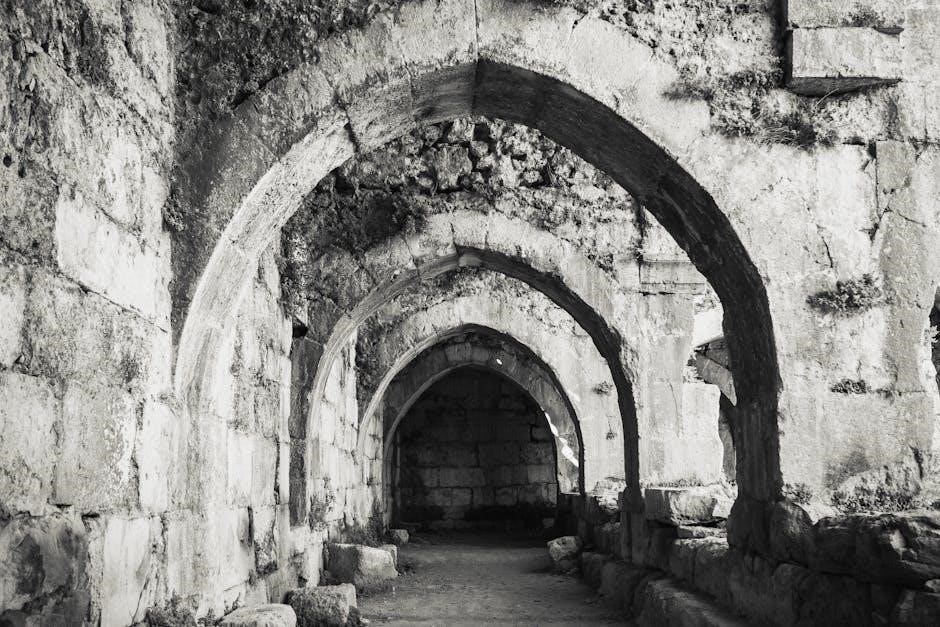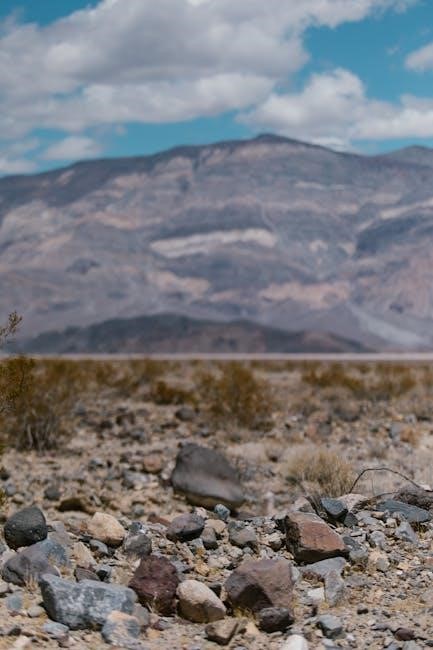Both Rough Guide and Lonely Planet are leading travel guidebooks, offering detailed insights for global explorers. Lonely Planet focuses on independent travelers, while Rough Guide emphasizes cultural depth, ensuring comprehensive and reliable updates for diverse travel needs.
1.1 Overview of Both Guidebooks
Lonely Planet and Rough Guide are two of the most popular travel guidebooks worldwide. Lonely Planet is renowned for its comprehensive coverage, catering to independent and budget travelers with practical advice. Rough Guide, on the other hand, offers in-depth cultural insights and detailed explorations of destinations. Both guides provide reliable information, but their approaches differ, making them suitable for different types of travelers. Their distinct styles ensure a wide range of travel needs are met.
1.2 Historical Background and Evolution
Lonely Planet, founded in 1973 by Tony and Maureen Wheeler, began with a focus on budget travel, while Rough Guide, established in 1982, emphasized cultural depth. Both guides have evolved to adapt to changing travel trends, expanding their coverage and embracing digital formats. Their commitment to detailed, reliable information has solidified their reputations as trusted travel companions, catering to diverse audiences and preferences over the years.
Target Audience and Traveler Preferences
Lonely Planet caters to independent and budget travelers, while Rough Guide appeals to diverse interests, offering insights for cultural explorers and adventure seekers alike globally.
2.1 Lonely Planet: Focus on Independent and Budget Travelers
Lonely Planet is renowned for catering to independent and budget travelers, offering practical advice on affordable accommodations, dining, and transportation. Its guides provide detailed insights into off-the-beaten-path destinations, making it ideal for those seeking authentic experiences. With a focus on cultural immersion, Lonely Planet helps travelers connect with local communities, emphasizing value and sustainability. This approach has made it a trusted companion for adventurers prioritizing flexibility and cost-effectiveness in their journeys worldwide.

2.2 Rough Guide: Appeal to Diverse Travel Interests
Rough Guide caters to a broad spectrum of travelers, offering detailed knowledge for both modern cities and remote landscapes. It provides in-depth cultural insights, historical context, and practical tips, appealing to those seeking immersive experiences. Whether exploring urban hubs or hidden gems, Rough Guide balances depth with timeliness, ensuring comprehensive coverage. Its approach attracts travelers with varied interests, from adventure seekers to culture enthusiasts, making it a versatile choice for diverse travel preferences and styles.
2.3 Differences in Reader Demographics
Lonely Planet primarily appeals to independent and budget travelers, often younger audiences seeking practical advice. Rough Guide, while also catering to budget-conscious travelers, attracts a broader demographic, including those interested in cultural depth and historical context. Lonely Planet’s readers often prioritize affordability and flexibility, while Rough Guide’s audience may skew slightly older, valuing detailed insights and immersive experiences. These differences reflect their content focus, with Lonely Planet emphasizing essentials and Rough Guide offering richer, more nuanced explorations.
Content Depth and Coverage
Lonely Planet offers comprehensive destination insights, while Rough Guide provides detailed cultural explorations. Both guidebooks ensure travelers gain deep, well-rounded knowledge of their chosen destinations.
3.1 Lonely Planet: Comprehensive Destination Insights
Lonely Planet is renowned for its thorough coverage of destinations, offering detailed insights into attractions, accommodations, and dining. It caters to independent travelers, providing practical tips and hidden gems. The guides are meticulously researched, ensuring up-to-date information. Whether exploring remote landscapes or vibrant cities, Lonely Planet delivers comprehensive knowledge, making it a trusted resource for travelers seeking immersive experiences worldwide.
3.2 Rough Guide: Detailed Exploration of Cultures and Landmarks
Rough Guide excels in offering in-depth cultural insights and detailed explorations of landmarks. It provides rich narratives that highlight local perspectives, making it a definitive choice for travelers seeking authentic experiences. Whether exploring modern cities or remote landscapes, Rough Guide delivers comprehensive knowledge, ensuring readers discover both iconic and hidden cultural gems with ease and depth.
3.3 Comparative Analysis of Information Quality
Lonely Planet and Rough Guide both deliver high-quality information, but their approaches differ. Lonely Planet is praised for its thoroughness, offering detailed practical advice and insights that cater to independent travelers. Rough Guide, while equally informative, focuses more on cultural depth and local perspectives, providing rich narratives. Both guides ensure accuracy, with Lonely Planet often considered more comprehensive and Rough Guide excelling in contextual storytelling, making the choice depend on the traveler’s preference for practicality or cultural immersion.

Tone and Writing Style
Lonely Planet offers a practical, informative tone, ideal for independent travelers seeking detailed insights. Rough Guide, with its engaging narratives, emphasizes local perspectives, appealing to culturally curious explorers.
4.1 Lonely Planet: Practical and Informative Approach
Lonely Planet is renowned for its practical and informative writing style, catering to independent and budget travelers. It provides detailed destination insights, tips, and recommendations, ensuring travelers can navigate seamlessly. The guides are thorough, offering in-depth information on accommodations, dining, and attractions. This approach makes it a trusted resource for those seeking reliable, up-to-date information. Its focus on accessibility and clarity has solidified its reputation as a go-to guide for global explorers.
4.2 Rough Guide: Engaging Narrative and Local Perspectives
Rough Guide stands out with its engaging narrative style, blending storytelling with local insights. It offers detailed cultural exploration, making readers feel connected to the destinations. The guides emphasize hidden gems and authentic experiences, appealing to travelers seeking depth. By incorporating local perspectives, Rough Guide provides a richer understanding of cultures and landmarks, making it a favorite for those who value immersive and meaningful travel experiences.
4.3 Which Style Suits Your Travel Needs?
Choosing between Lonely Planet and Rough Guide depends on your travel style; Lonely Planet’s practical approach suits independent and budget travelers needing clear, concise information. Rough Guide’s narrative depth appeals to those seeking cultural immersion and local perspectives. If you prioritize detailed insights and storytelling, Rough Guide is ideal. For straightforward, reliable guidance, Lonely Planet is the better choice. Both cater to different preferences, ensuring travelers find the perfect fit for their adventures.

Update Frequency and Accuracy
Lonely Planet and Rough Guide prioritize updates, ensuring travelers receive reliable information. Both guides maintain high standards, with Lonely Planet focusing on regular revisions and Rough Guide balancing depth with timeliness for accurate, up-to-date content.
5.1 Lonely Planet: Regular Updates and Reliable Information
Lonely Planet is renowned for its consistent updates, ensuring travelers access the most current information. Their guides are meticulously researched, with a focus on accuracy and relevance. This dedication to regular revisions makes them a trusted source for planning trips, whether exploring popular destinations or venturing off the beaten path. The frequency of updates ensures that travelers can rely on the information provided, making Lonely Planet a go-to choice for many globetrotters seeking dependable guidance;

5.2 Rough Guide: Balance Between Depth and Timeliness
Rough Guide strikes a balance between in-depth content and timely updates, offering detailed insights while maintaining relevance. Their guides are known for thorough research, providing rich cultural context and practical advice. While updates may not be as frequent as Lonely Planet, the depth of information ensures travelers gain a comprehensive understanding of destinations. This approach appeals to those seeking both detailed exploration and up-to-date information, making Rough Guide a preferred choice for travelers valuing depth and accuracy.
5.3 User Feedback on Guidebook Accuracy
Users often praise Lonely Planet for its reliability, though some note occasional outdated information. Rough Guide is commended for its detailed cultural insights, but updates can be less frequent. Travelers generally appreciate both guides’ accuracy, with preferences leaning toward Lonely Planet for practicality and Rough Guide for depth. Feedback highlights that while neither is perfect, both remain trusted resources for planning memorable journeys, catering to different traveler priorities and expectations.

Visual Appeal and Design
Lonely Planet is renowned for its iconic covers and organized layouts, while Rough Guide offers modern, vibrant designs with stunning photography, appealing to different aesthetic preferences.

6.1 Lonely Planet: Iconic Covers and Layout
Lonely Planet is celebrated for its iconic, visually striking covers that instantly capture destinations’ essence. The guides feature clean, organized layouts with clear headings and sections, making navigation effortless. High-quality images and detailed maps complement the text, enhancing the reader’s planning experience. The design is both functional and aesthetically pleasing, reflecting the brand’s commitment to inspiring wanderlust. These elements combine to create a user-friendly guide that appeals to travelers seeking both practicality and visual inspiration.
6.2 Rough Guide: Modern Design and Photography
Rough Guide stands out with its modern, sleek design and captivating photography. The guides feature vibrant images that highlight both iconic landmarks and hidden gems, offering readers a visual journey. The layout is clean and intuitive, balancing aesthetics with functionality; Detailed maps and well-organized sections enhance usability. Rough Guide’s photography emphasizes local cultures and landscapes, providing travelers with authentic visual insights. This blend of modern design and compelling imagery makes the guides both inspiring and practical for planning memorable trips.
6.3 Which Guide is More Visually Appealing?
Both guides excel visually, but their styles cater to different preferences. Lonely Planet is renowned for its iconic, instantly recognizable covers and practical, user-friendly layouts. Rough Guide, on the other hand, impresses with its modern, vibrant photography and sleek design. While Lonely Planet focuses on clarity and accessibility, Rough Guide emphasizes artistic expression and cultural immersion. Ultimately, the choice depends on whether you prioritize functionality or aesthetic appeal in your travel guide.

Digital Presence and Online Resources
Both guides offer robust digital platforms. Lonely Planet provides a website, apps, and tools for trip planning. Rough Guide features online content and interactive travel guides.
7.1 Lonely Planet: Website, Apps, and Digital Tools
Lonely Planet offers a comprehensive digital presence with a user-friendly website and mobile apps. Features include interactive maps, destination guides, and booking options for accommodations and tours. The apps provide offline access, essential for travelers without reliable internet. Real-time updates and personalized itineraries enhance the planning experience. Additionally, Lonely Planet’s digital tools cater to diverse travel styles, offering tips for budget travelers and luxury seekers alike. These resources ensure travelers stay informed and connected, making Lonely Planet a trusted companion for modern explorers.
7.2 Rough Guide: Online Features and Interactive Content
Rough Guide enhances travel planning with a robust online platform featuring interactive maps, cultural insights, and photo galleries. Their website offers detailed destination guides, travel tips, and user-generated content. The Rough Guide travel blog provides fresh perspectives and insider knowledge. Additionally, the guide’s social media channels engage travelers with stunning visuals and real-time updates. These digital resources complement their print guides, offering a seamless experience for travelers seeking inspiration and practical advice for their journeys.
7.3 Comparison of Digital Offerings
Lonely Planet and Rough Guide both excel in digital offerings, catering to modern travelers. Lonely Planet provides a user-friendly website, mobile apps, and digital tools for on-the-go planning. Rough Guide complements its print guides with interactive features like maps, photo galleries, and travel blogs. While Lonely Planet focuses on practicality, Rough Guide emphasizes cultural immersion. Both platforms offer updated information, but Lonely Planet’s apps are more polished, whereas Rough Guide’s online content is praised for its depth and visual appeal, making them suited for different traveler preferences.
User Reviews and Traveler Experiences
Travelers praise both guides for reliability, but preferences vary. Lonely Planet is often favored for its thoroughness, while Rough Guide is admired for its cultural insights and up-to-date information.
8.1 Lonely Planet: Feedback from Long-Time Users
Long-time users of Lonely Planet often praise its reliability and depth, with many appreciating its thorough insights and practical advice. Some travelers highlight its ability to cater to independent and budget-conscious explorers, making it a trusted companion for decades. However, a few users have noted that while Lonely Planet remains a solid choice, its updates and quality have seen some fluctuations over the years, leading to mixed opinions among loyal followers.

8.2 Rough Guide: Testimonials and Traveler Stories
Travelers often praise Rough Guide for its detailed insights and cultural depth, sharing stories of discovering hidden gems and immersive local experiences. Many users appreciate its balanced approach, blending practical advice with rich narratives. Some prefer Rough Guide over Lonely Planet for its up-to-date information and comprehensive coverage of diverse destinations. While a few find it slightly less thorough in certain regions, it remains a top choice for travelers seeking authentic and engaging content to enhance their journeys.
8.3 Common Praises and Criticisms
Both guides receive praise for their detailed destination insights, but Lonely Planet is often criticized for being less up-to-date, while Rough Guide is admired for its cultural depth. Some users find Lonely Planet more comprehensive, yet others prefer Rough Guide’s engaging narratives. Criticisms include occasional inaccuracies and outdated information in Lonely Planet, whereas Rough Guide is sometimes seen as less thorough in certain regions. Overall, both guides are valued for their unique strengths, catering to different traveler preferences and needs effectively.

Expert Opinions and Recommendations
Travel bloggers and industry experts often recommend choosing between Lonely Planet and Rough Guide based on specific travel styles, with Lonely Planet favored for detailed insights and Rough Guide praised for cultural depth and engaging narratives.
9.1 Travel Bloggers’ Preferences
Travel bloggers often express varied preferences between Rough Guide and Lonely Planet. Many praise Lonely Planet for its thorough destination insights, making it a favorite for detailed planning. Conversely, some bloggers prefer Rough Guide for its engaging narratives and deep cultural exploration. A few highlight Lonely Planet’s practicality for budget travelers, while others appreciate Rough Guide’s ability to uncover hidden gems. Ultimately, the choice often aligns with the blogger’s travel style and the specific destinations they cover.
9.2 Industry Experts’ Views on Both Guides
Industry experts often commend both Rough Guide and Lonely Planet for their unique strengths. Lonely Planet is frequently praised for its reliability and comprehensive coverage, making it a trusted resource for independent travelers. Rough Guide, on the other hand, is celebrated for its rich cultural insights and engaging storytelling. Experts highlight that Lonely Planet excels in practical advice, while Rough Guide offers deeper dives into local traditions and hidden gems. Their recommendations often align with the traveler’s specific needs and preferences.
9.3 Which Guide is More Recommended?
Experts often highlight that the choice between Rough Guide and Lonely Planet depends on individual travel preferences. Lonely Planet is frequently recommended for its thorough, practical advice, making it ideal for independent and budget-conscious travelers. Rough Guide, with its rich cultural narratives, is often suggested for those seeking deeper immersion. While both are highly regarded, Lonely Planet’s reliability and comprehensive updates give it a slight edge for many, though Rough Guide’s storytelling resonates with culturally curious explorers.
Both Rough Guide and Lonely Planet excel in providing comprehensive travel insights. Lonely Planet’s practicality and Rough Guide’s cultural depth cater to different traveler preferences, ensuring informed adventures.
10.1 Summary of Key Differences
Rough Guide and Lonely Planet cater to distinct traveler needs. Lonely Planet excels with practical, detailed insights for independent and budget travelers, while Rough Guide offers deeper cultural exploration. Lonely Planet’s updates are frequent, ensuring reliability, whereas Rough Guide balances depth with timely information. Visually, Lonely Planet’s iconic covers stand out, while Rough Guide’s modern design appeals to aesthetics. Both guides provide digital tools, but Lonely Planet’s comprehensive app is notably popular. Ultimately, the choice depends on whether cultural immersion or practicality is prioritized.
10.2 Choosing the Right Guide for Your Travel Style
Lonely Planet is ideal for independent and budget travelers seeking practical, detailed insights. Rough Guide suits those who value cultural immersion and in-depth explorations. If your travel style prioritizes affordability and essential information, Lonely Planet is perfect. For a richer, more narrative-driven experience with a focus on local cultures, Rough Guide is the better choice. Both guides cater to unique preferences, ensuring travelers can select the one that aligns with their adventure goals and expectations.
10.3 Future of Travel Guidebooks
Both Lonely Planet and Rough Guide are adapting to the digital age, offering apps and online resources to complement their print editions. While Lonely Planet focuses on practical tools for independent travelers, Rough Guide enhances its digital presence with interactive content. The future likely holds a blend of traditional guidebooks and innovative digital formats, ensuring these iconic guides remain relevant for modern explorers seeking reliable, up-to-date information and immersive cultural insights.
